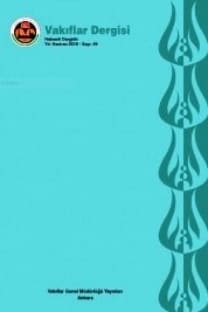A Look at the Cash Waqfs as an Indicator of Ottoman Financial Mentality
Cash Waqfs, Ottoman Empire, Islamic Finance, Philanthropy, Altruistic Finance Model, basic principles of cash waqfs
___
- Akgündüz, Ahmet. (1996). İslâm Hukukunda ve Osmanlı Tatbikatında Vakıf Müessesesi. Osmanlı Araştırmaları Vakfı.
- Berki, Ali Himmet. (1962). “Vakıf Kuran İlk Osmanlı Padişahı”. Vakıflar Dergisi, 5: 127-129.
- Bulut, Mehmet; Korkut, Cem. (2016). “A Comparison Between Ottoman Cash Waqfs (CWs) and Modern Interest-free Financial Institutions”. Vakıflar Dergisi. 46: 23-45.
- Gökbilgin, Mehmed Tayyib. (1952). XV.-XVI. Asırlarda Edirne ve Paşa Livâsı: Vakıflar, Mülkler, Mukataalar. İstanbul: İstanbul Üniversitesi Edebiyat Fakültesi Yayınları, No: 508, Üçler Basımevi.
- Mandaville, Jon E. (1979). “Usurious Piety: The Cash Waqf Controversy in the Ottoman Empire”. International Journal of Middle East Studies. 10(3): 289-308.
- Okur, Kaşif Hamdi. (2005). “Para Vakıfları Bağlamında Osmanlı Hukuk Düzeni ve Ebussuud Efendinin Hukuk Anlayışı Üzerine Bazı Değerlendirmeler”. Hitit Üniversitesi İlahiyat Fakültesi Dergisi, 4(7-8): 33-58.
- Özcan, Tahsin. (1999). “Sofyalı Bâlî Efendi’nin Para Vakıflarıyla İlgili Mektupları”. İslâm Araştırmaları Dergisi, (3): 125-155.
- Özcan, Tahsin (2000). “İbn Kemal’in Para Vakıflarına Dair Risâlesi”. İslâm Araştırmaları Dergisi, Sayı (4): 31-41.
- Pamuk, Şevket (2004). “Institutional change and the longevity of the Ottoman Empire. 1500–1800”. Journal of Interdisciplinary History, 35(2): 225-247.
- Pamuk, Şevket (2012). Osmanlı İmparatorluğu’nda Paranın Tarihi. İstanbul. Tarih Vakfı Yurt Yayınları.
- Sıddıki, Muhammad Nejatullah. (1982). “Recent Works on History of Economic Thought in Islam: A Survey”. International Center for Research in Islamic Economics. Research Series in English No.12. Jeddah: King Abdulaziz University.
- Şimşek, Mehmet (1986). “Osmanlı Cemiyetinde Para Vakıfları Üzerinde Münakaşalar”. Ankara Üniversitesi İlahiyat Fakültesi Dergisi, 27(1): 207-220.
- Uzunçarşılı, İsmail Hakkı (1988). Osmanlı Devleti Teşkilâtından Kapıkulu Ocakları 1. Ankara. Türk Tarih Kurumu Yayınları.
- ISSN: 1011-7474
- Yayın Aralığı: 2
- Başlangıç: 2015
- Yayıncı: Mehmet Kurtoğlu
Prof. Dr. İlber Ortaylı İle Vakıf Medeniyeti Üzerine
Hocası Prof. Dr. Rahmi Hüseyin Ünal’ın Kaleminden Sanat Tarihçi Yekta Demiralp
Nakid Para Vakfı İle İlgili Çivi-zâde’nin Ebussu‘ûd’a Yazdığı Reddiye Risâlesi
İktisat Tarihi Açısından Vakıflar
Orhan Cezmi Tuncer: Her Vakıf Yapısında Tanrısal Güzelliği Gördüm
Türkiye’deki Bizans Sanatı Tarihinin Bir Çınarı: Hocam Prof. Dr. Yıldız Ötüken
Vakıflar Dergisi 2013-2019 Yayın Dönemi (40-50. Sayılar) Değerlendirmesi ve Bibliyografyası
A Look at the Cash Waqfs as an Indicator of Ottoman Financial Mentality
Osmanlı Su Yapılarında Vakıfların Rolü: Tesis, Onarım ve Hizmet Giderlerinin Finansmanı
Tuna Sahilinde On Altıncı Yüzyılda Kurulmuş Bir Osmanlı Yerleşimi: İsmail Geçidi Kasabası
